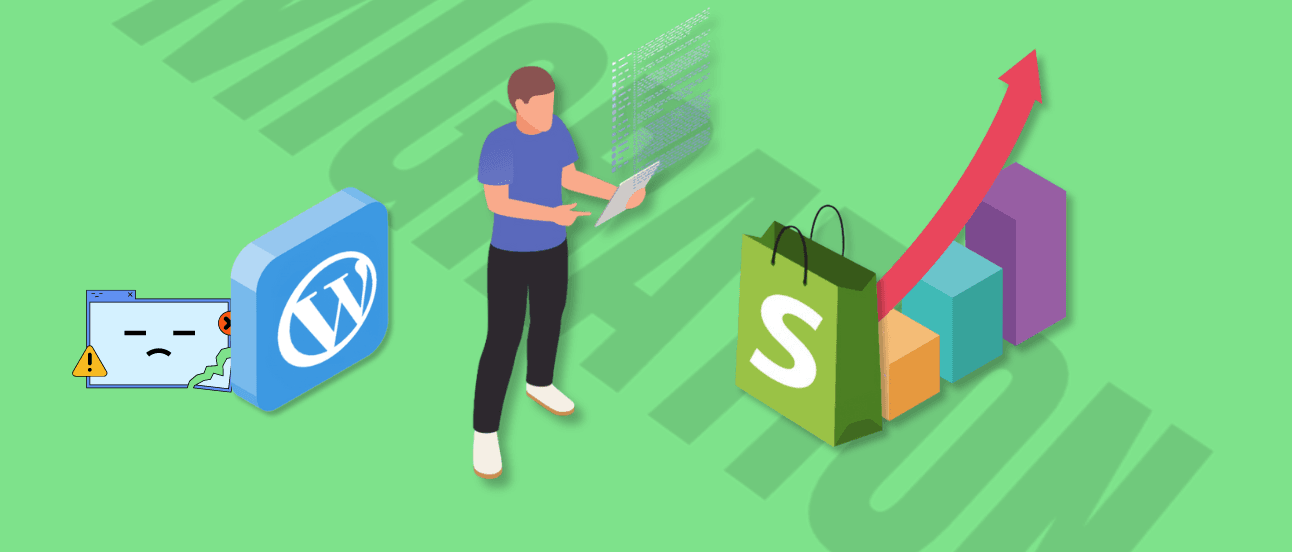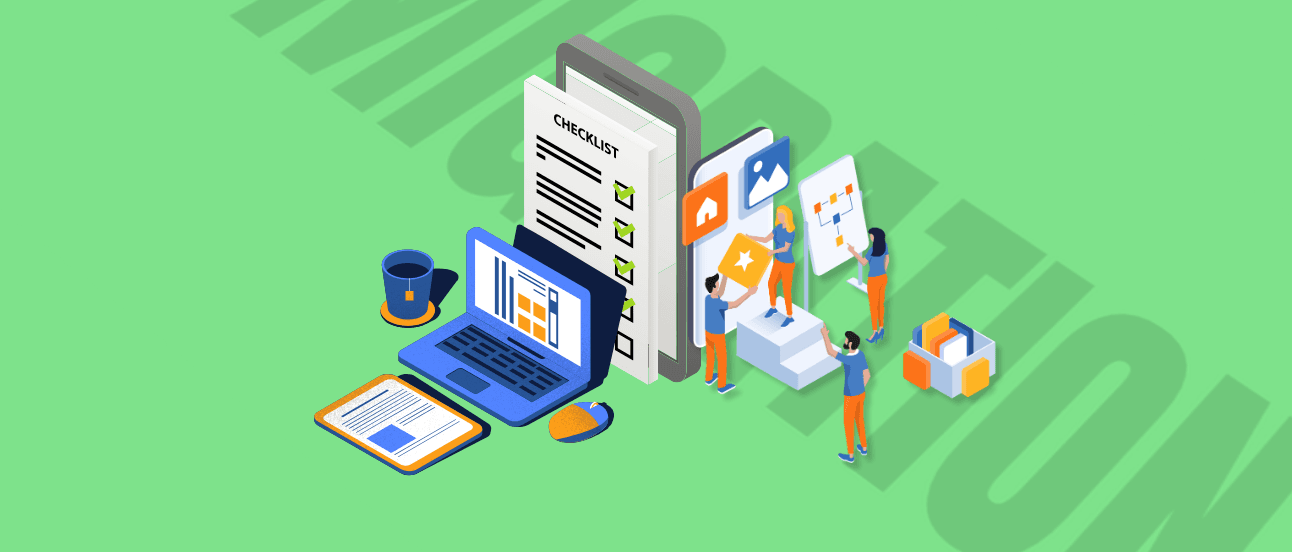What Is Headless Commerce?
Headless e-commerce becomes more popular. Since it gives you more flexibility and allows for a personalized user experience, it may be a good idea to switch from traditional commerce to a headless commerce solution.
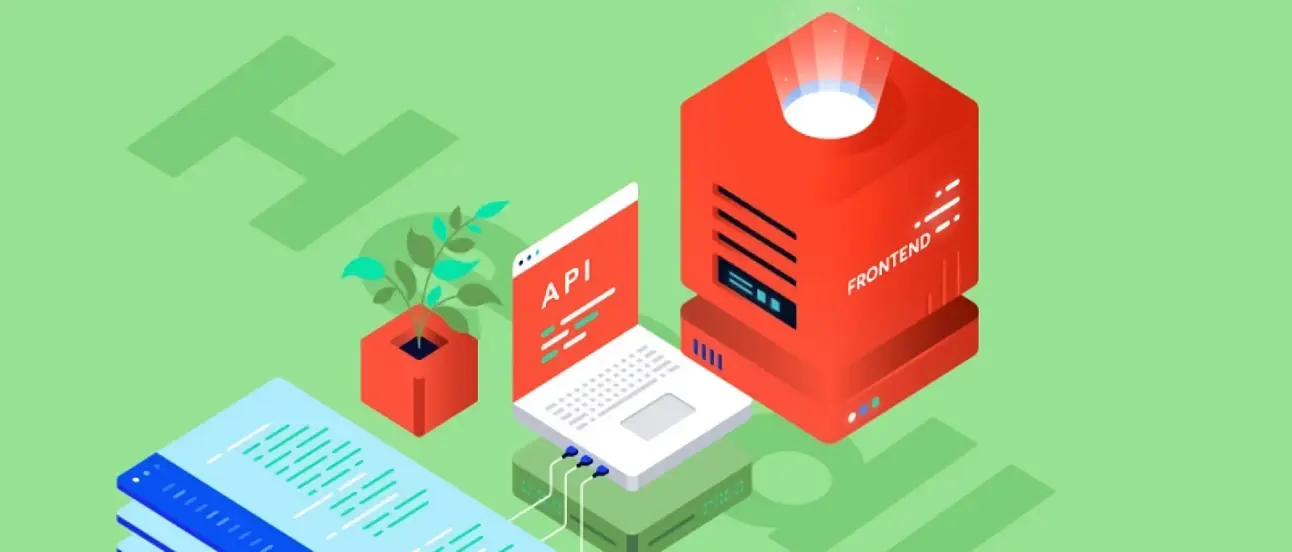
Headless e-commerce becomes more popular. Since it gives you more flexibility and allows for a personalized user experience, it may be a good idea to switch from traditional commerce to a headless commerce solution. Many headless storefront platforms embrace the possibilities offered by this technology.
That's because customers are becoming more demanding and have higher needs. And you should keep up with their expectations and changing trends on the market to grow your business. That’s what headless e-commerce can help you with.
If you're wondering what is headless commerce, how it works, and why it's better than a traditional platform for building an e-commerce website, we'll help you understand all the intricacies of headless.
What Is Commerce Platform?
Let's begin with the basics. Before digging deeper into ecommerce and all things headless, it's a good idea to get to know commerce better. It'll help you properly understand the magic behind ecommerce platforms and headless commerce architecture.
So what is a commerce platform and why is it important when talking about headless systems? There's not much philosophy behind this concept. Commerce platform is an architecture that lets you make transactions (commerce) via technology (platform) with the use of consumer technology, e.g., computers, laptops, smartphones, and other IoT devices.
The final product of the commerce system is the ecommerce website — a place where you can sell products, and your customers can easily buy them from any place in the world.
Customers are becoming more demanding and have higher needs so you need to keep up with their expectations and changing trends in the market to grow your business. That's what headless e-commerce can help you with.
Some of the most popular providers of commerce functionality are, for example, Shopify, Weebly, or BigCommerce. These offer an entire system to create ecommerce sites for your ecommerce business.
Ecommerce functionality is crucial for every ecommerce store. It has all the elements necessary to have an ecommerce platform, beginning from a content management system (CMS), user interfaces, to digital asset management (DAM), and payment processing among others.
Commerce Platform and Headless Commerce System
Every ecommerce platform has its commerce engine. It's the heart that fuels all ecommerce platforms and enables people to buy from you.
But every commerce system can be different. And not every ecommerce solution will be the same—not every online store looks and works alike. That's because each business has different needs, targets a different niche, and operates in a distinct way. And how you want your ecommerce store to look and function should correspond to your ecommerce strategy and business model.
So before you decide on which commerce engine you want to build your ecommerce platform, you need to think about whether it'll be better to base your ecommerce business on a traditional ecommerce platform or make it more flexible for customer interaction thanks to the headless commerce approach.
We suggest the latter, since headless commerce architecture offers more opportunities for growth, and is much more adaptable to changes and new ideas.
Headless architecture in 2 sentences
It's decoupling (separating) the front-end of your system from the back-end. This allows you to create the architecture just the way you'd like it to be.
Exploring the Headless eCommerce architecture model
Headless ecommerce, headless commerce, headless CMS, decoupled architecture — headless has many names.
Headless commerce may seem a complicated concept behind which lies an advanced, hard-to-harness technology. But in reality, the "headless commerce" is simple. It's decoupling (separating) the front-end of your system from the back-end.
In other words, it's removing the main database from the presentation layer (theme, layout, images, etc.). That allows you to create the architecture just the way you'd like it to be.
With "heads" (decoupled front-end) you can customize the front-end, make flexible changes to the themes, template, layout, pictures, and anything else your customer sees upon entering your site. The back-end, on the other hand, is like a core body. And your body can have as many different heads as necessary.
In other words, in headless commerce architecture, you don't base your platform on one tool, but can freely use different technology for front-end and back-end to create a better user experience and engage customers to get more leads.
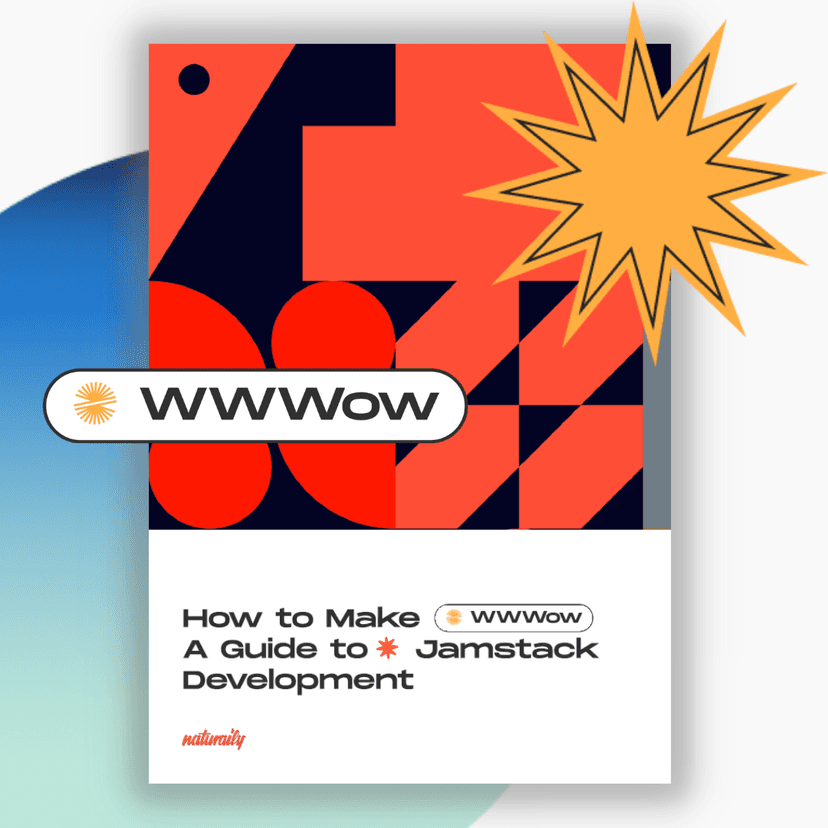
Need a better website?
Jamstack development described
Business reasons to switch
How to get started
All you need to know
80 pages for free!
Traditional Commerce vs Headless Commerce
Let's dive a bit deeper into the traditional ecommerce model and headless commerce architectures. The difference between the two is simple and crucial if you're wondering which is better for your business and fits your ecommerce strategy more.
Traditional e-commerce
Traditional commerce platforms are based on monolithic architecture. It means that there's one, unified model for the design of the platform. A traditional e-commerce site is usually large and difficult to change. It's also based on a long, hard-to-maintain source code with a fixed framework.
The most important aspect of classic commerce is its back-end–front-end integration. The "head" is fixed — coupled — and you can't attach any other elements. That is, the back-end is tightly connected to a preset front-end.
That gives you sparse options for customization and may cause delayed innovation. It's heavily limited in delivery and layout options. Also, it may not always be possible to deliver the content to other means than a website or mobile app.
Such a framework is best for well-established businesses, personal websites with blogs and portfolios, and other similar content. Since they don’t require much intervention and digging in code, it'll be easier to maintain them. They don't need the custom checkout flow and may be built in one programming language.
Traditional commerce requires staying with one fixed system, which usually offers limited possibilities of changing the design or adding new features. It also requires a lot of optimization because, the bigger an online store becomes, the worse performance becomes, and the traditional platform slows down.
Some of the best examples of monolithic platforms are those built on WordPress. It's an environment where you create all platforms within one platform. Although you can add extensions to make your experience more customizable, you're still limited by just one platform.
Headless commerce system
In contrast to traditional e-commerce, headless commerce is about separating the front-end layer (head) from the back-end layer (body), hence the name. This technique is called decoupled architecture. You can attach one or more “heads” to the “body” or change them anytime to create an entire system that suits your needs. This approach enables total e-commerce website design freedom so online store owners can create personalized customer experiences.
This architecture allows you to create a fully customized, multi-layered environment to deliver a perfect website and do the tiniest tweaks at every level. You can have multiple sites with advanced functionalities and add as many different functionalities as you need.
The headless commerce approach also allows for connecting online stores with different tools that are laser-focused on one aspect of online store functioning through API (Application Programming Interface). Therefore, you can choose one tool for payments, another one for the live search function, and so on.
In general, headless architecture lets you freely move around your commerce environment and look into every nook and cranny of your platform. It's lightweight and offers endless possibilities.
In short, traditional commerce means heavy, monolithic architecture while headless is an API-driven, developer-friendly environment.
In short, traditional commerce means heavy, monolithic architecture while headless is an API-driven, developer-friendly environment
How Does Headless Commerce Work?
When using a headless solution to create a website, you can divide it into two stages: preparing the content and customizing the design.
Here's how it looks like in a few steps:
Store — you enter the content into the database
Manage — you manage it, change, adjust, and customize
Deliver — you deliver the content to a chosen front-end, so here’s how it's going to look as a dynamic material. It's an easy way to change the layout without getting rid of content data. Here, you use APIs (Application Programming Interface) for transferring the data between the backend system and the presentation layer.
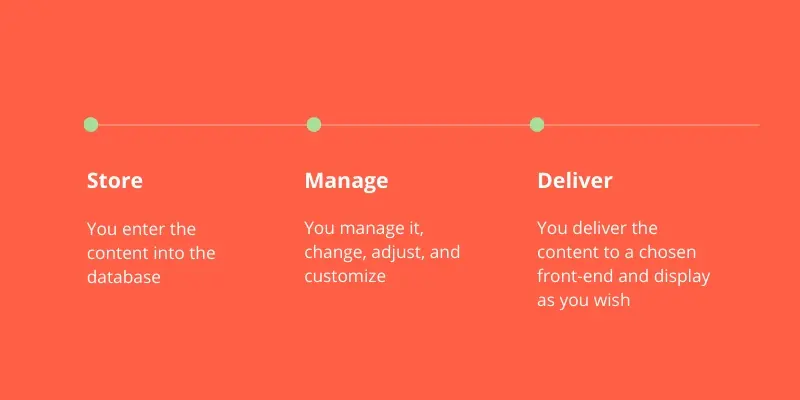
Headless commerce allows you to quickly deliver content and build a data repository and inventory management system, for example, for all the products you want to have in your e-store. That way, you don't have to focus on tiresome digging in the code.
Progressive Web Apps & Headless Solutions
Headless commerce platforms are adaptable, but you already know that. This flexibility opens a lot of possibilities for your ecommerce brand. The headless commerce approach uses digital experience platforms (DXP). This means that with the use of consumer technology, everything works across different digital touchpoints and makes headless ecommerce platforms easily accessible to users globally.
That's possible with the progressive web apps (PWA). Headless API with the PWA enables you to create a mobile version of your ecommerce solution without the need to make an additional mobile application that users would otherwise have to download on their smartphone.
PWA allows your headless platform to use the features used in mobile apps:
Offline mode
Camera
Payment gateway
Adding the ecommerce platform to screen
Location spotting
Bluetooth
Push notifications
It's especially helpful because PWA in headless commerce lets you engage customers even more and makes it easier to reach out to them with a friendly, intuitive user interface.
In this case, headless storefronts are the opposite of monolithic platforms. Traditional platforms don't offer such freedom and limit your existence to just one platform. Or you need to build a dedicated app strictly connected with the presentation layer.
Orange's PWA Case Study
New PWA converts 52% better on mobile. The new PWA also has an average loading time 30% faster than the old site and has improved bounce rate 12% and session depth 18%.
Why Is Headless Commerce Better Than Traditional?
Since ecommerce is a fast-growing, competitive niche, it requires innovative solutions. The headless commerce approach helps to implement quick changes and boost growth.
Here are all the reasons for which headless is better than traditional ecommerce platforms from a technical point of view.
Full flexibility
Since back-end and front-end are decoupled, you decide what to do with the two.
When it comes to the back-end, your developers can choose their favorite framework so they can have a better user experience as admins.
The front-end enables devs to adapt the platform via APIs so they have all the right tools for the job, and use any programming language to their advantage.
Headless commerce gives you a lot of flexibility, agility to discover new developing solutions, test new ideas and designs, and implement the latest trends. It's entirely up to you how you build the platform.
Easier to maintain
In headless commerce, there's no long code to dig around in, and no need to modify the databases that are located deep under different layers of code.
You can easily manage all your content, catalogs, data, inventory management system, and more in one place. You don't have to switch between different vendors, software, and systems.
Additionally, it's easier to spot and fix bugs and maintain continuity within the platform, the heads and the main body.
Continuous development
One of the assumptions of a headless approach is to be able to use modern technology to provide a flexible environment for a website.
It's helpful in A/B testing to find out how customers behave and interact with the website to improve CX.
What's more, development teams responsible for back-end and front-end don't have to interrupt each other but can work more efficiently, and even collaborate better. Smooth processes ensure fast innovation, a quick and steady pace of change, and better adjustability to the customer needs of your ecommerce.
Statistics show that 86% of buyers are willing to pay more for a great customer experience. If you want to meet their needs, you need to be ready for change and innovation. And there's no better way to do it than to adopt the headless solution.

Check how we used the Jamstack approach in one of our web development projects: dajemyslowo.com
Check case studyImproved developer experience
Headless ecommerce platform is fully customizable not only from the side of user experience but also developer experience. Your IT team can choose which framework they want to work in, what tools to use, and what methodology suits them best.
You control how everything works and looks like as an admin and builder of the code. You own the architecture.
It makes work easier and more enjoyable. As a result, the end product is delivered faster, better, and in high quality.
Better performance
The headless approach ensures scalability and high performance.
You don't have to worry when your site goes down or has some glitches. It's much easier to fix bugs and add patches when the back-end and front-end are separated.
Headless commerce is focused on delivering fast results in the most convenient way.
Integrated commerce experience
With headless ecommerce, you can customize the user experience for every stage of the buyer's journey. That way users engage more with the platform. Instead of separate links and references, you have all the touchpoints smoothly integrated.
That provides better adjustability to client's changing needs. And your developers can ensure an undisturbed buyer's journey, from beginning to end.
It also means your customers can engage with your brand from any device.
Lower cost of maintenance
Headless is cheaper than traditional commerce. When you operate on separate pieces, it requires less engagement from fewer people. Especially, if you want to introduce smallish changes.
Additionally, when you use external APIs or web services, and third-party apps, you can save money on some of the aspects of DevOps and maintenance of the servers.
The Pros and Cons of Headless Commerce
Despite the fact, that headless commerce offers possibilities for quick innovation and saves a lot of time and money, it has its flaws.
Let's look at the bigger picture and analyze all the pros and cons of a headless solution for you and the customers.
The Pros of Headless Commerce architecture
There's a reason why headless commerce is gaining popularity and has many advocates.
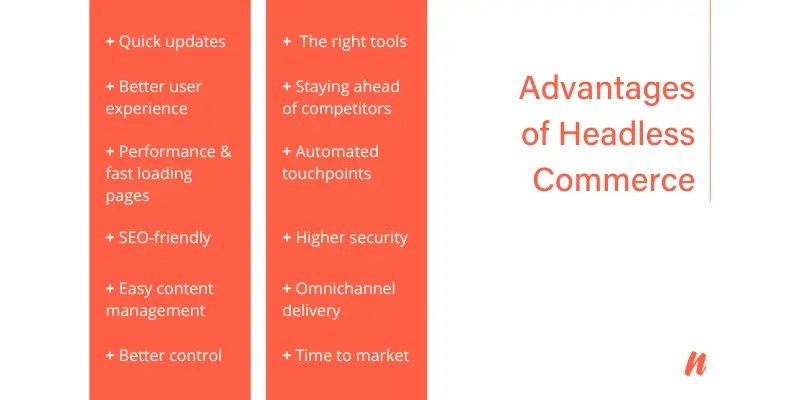
Here are the benefits of headless commerce solution:
Quick updates — all changes are implemented with a blink of an eye on the contrary to sites built on classic architecture.
Better user experience — with a fully customizable front-end, you can create a perfect UX to attract more customers. Also, the user interface within headless CMS isn't problematic for developers and store owners.
Performance & fast loading pages — headless commerce supports fast delivery of websites so all changes happen quickly, thereby your site will load much faster. It's widely known that if a page takes more than 3 or 4 seconds to load, the visitor will leave it. Headless prevents that from happening.
The right tools — the APIs allow you to add whatever you want with pre-built integrations. That gives the developers full control of how the end-product will look like but also what environment and framework they work within.
Time to market — with headless commerce, businesses can react quickly to changes. It's helpful also for marketing teams who need to take care of all things marketing-related.
Automated touchpoints — payment, shipping procedures, and other commerce processes can be easily automated for even better customer experience
Higher security — because the headless as a development ecosystem is less vulnerable to outside breaches, the safety of your website and client information is ensured. Additionally, using the API for queries instead of SQL technology protects against SQL injection attacks.
Better control — the separation of back-end from front-end helps to save time; you don't have to find lines of code, interfere with the databases. The management is much easier and straightforward.
Easy content management — simple to use admin for content editing, product management, and visual e-commerce website design. Headless commerce platform ensures that you have all the ecommerce stack at hand.
Omnichannel delivery — multi-channel servicing is on the rise. People want to buy more and quicker via different channels. Headless allows you to deliver your site to any device connected to the web, be it a smartphone, smartwatch, laptop, or tablet, with the digital experience platform.
Staying ahead of competitors — quick change, embracing innovation, tailored customer experience, high performance, and flexibility — you get it all when using headless commerce technology. That helps you become a serious competitor for other brands from your niche.
SEO-friendly — Google and other web browsers like well-performing, fast, and secure pages. Headless gives you all these elements at once. It's easier for your marketing team to position your brand and reach out to more people.
The Cons of Headless Commerce platforms
Requires technical skills — you need to have a front-end developer, or an entire team if you're building a large e-commerce site
Complex design — if you're looking for a simple solution that doesn't require lots of customization and personalization, headless may not be right for your business.
Higher cost of dev teams — in e-commerce development, you may need to hire many people when building a complex platform with multiple features. And the more developers you hire to build and maintain your system, the higher the costs.
More content to manage — managing content with headless is a bit like adding another smaller piece to the puzzle. It gets bigger and requires more management.
Overall, the pros outweigh the cons. Using the API-driven architecture offers many more positive aspects than sticking to the classical, old-fashioned monolithic one.
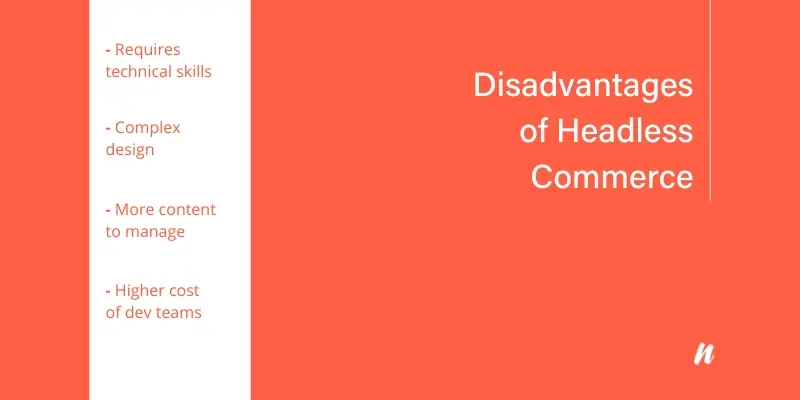
Headless Commerce Solutions
You now know all the technicalities of headless technology. To give you some examples that may inspire you, here are a few use cases:
Salesforce commerce cloud
Salesforce commerce cloud is one of the most popular headless commerce platforms. Many stores are built on Salesforce. It offers such functionalities as marketing, merchandising, content, promotions, customer service, artificial intelligence, and many more. Salesforce commerce cloud is best for non-tech people who want a ready solution.
Jamstack
Jamstack Development is an approach that allows you to build dynamic pages with third-party apps and APIs. It's perfect for building a fully customizable headless commerce platform for people with strong technical skills and website development knowledge.
BigCommerce
BigCommerce may be an alternative to Salesforce. It allows you to implement headless on any other platform to streamline management.
You can also check your favorite or most popular ecommerce brands to look out for interesting solutions.

Wish to learn more about What is Jamstack?
If yes, that's great. We did our best so you can grasp the topic easily!
Headless Commerce - Conclusion
Without any doubt, headless commerce is the future of ecommerce. Quick changing needs of customers and market trends will force businesses to reinvent their approaches.
Is your ecommerce ready for innovation? If you need help switching to headless architecture and are looking for a professional ecommerce development company, we'll give you a hand!
Remember that the crucial aspect in deciding what type of infrastructure you need for your ecommerce depends on your business needs, niche, and other factors. Drop us a line and we can talk!
Let's talk about Jamstack and headless e-commerce!
Contact us and we'll warmly introduce you to the vast world of Jamstack & headless development!



